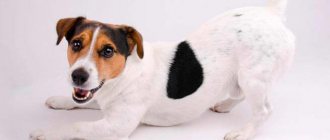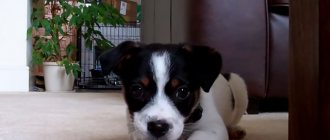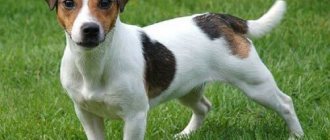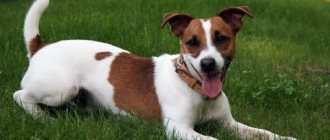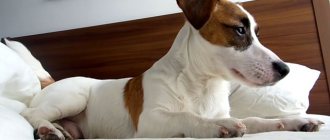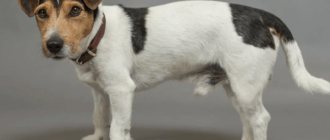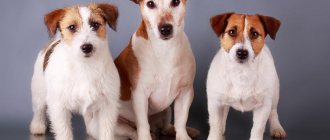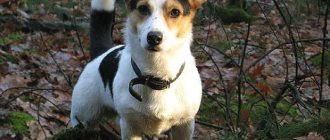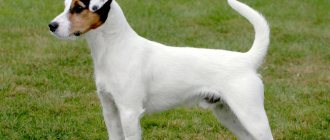Jack Russell is the main character of the film “The Mask.” If you think that a perpetual motion machine has not yet been invented, then here is a clear example for you - the Jack Russell Terrier breed, which has rightfully earned the title of the most active dog in the world. A positive and friendly pet – isn’t this the dream of every animal lover? A little prank won't hurt. Moreover, television screens show a cutie with an obedient, albeit restless character. But is everything so simple with this little hunter? Descriptions and characteristics of Jack Russell Terrier dogs will help you understand whether they are suitable for your family.
Description of the Jack Russell Terrier breed
A small but strong dog is the result of the hard work of several generations of breeders. The passion for fox hunting in the 19th century led to the active breeding of an individual capable of driving the animal out of its hole.
These were not the most attractive representatives of canines - with a massive head, an awkward, at first glance, body, and a short neck. The description of the breed of that time, of course, differs significantly from current standards of exterior, but the character is, perhaps, very similar.
“Truly working terriers differ from existing show dogs, just as a wild rose differs from a garden rose, but they have more charm and naturalness.” This is what the Reverend Jack Russell wrote about this breed.
The priest deduced the ideal parameters of a working specimen:
- Endurance.
- Balanced character.
- Maneuverable body.
- Grasping jaw.
- Ears protected from excess debris.
- Loud, ringing bark.
And today the Jack Russell Terrier is one of the best breeds of service dogs - hardy, reliable, active. Representatives are compact and proportional. Of course, nowadays there are general standards for Jack Russells - regardless of whether they participate in hunting or not.
The compact, muscular terrier is recognizable by its white coat with distinct brown or black spots. Although small in stature, individuals have strength, tenacity, and a powerful jaw.
Exterior of the breed
History of the breed
The Jack Russell Terrier has long been a variation rather than a distinct breed. The English priest John (Jack) Russell created them in order to hunt burrowing animals and did not know that in the future his dogs would become one of the most popular breeds in the world.
The word terrier comes from the Latin word terra - earth, which later became the French terrarius. One interpretation of the name is a dog that crawls underground.
The first written mention of terriers dates back to 1440, although they are much older. Despite their English origins, terriers most likely arrived on the islands as early as 1066, during the Norman Conquest.
Roman sources mention that the British had small hunting dogs, with the help of which they caught burrowing animals.
Unlike other dog breeds, the history of terriers is clearly traced. Finds made at Hadrian's Wall (122-126) include the remains of two types of dogs. One of them resembles a modern whippet, the other a dachshund or sky terrier.
This suggests that terriers existed thousands of years ago and looked much the same as they do today. Their real origin is a mystery, but they have been associated with England for so long that it has come to be considered the birthplace of the breed.
For centuries they have been used to hunt small animals and kill rodents. They are able to cope with fox, hare, badger, muskrat and become indispensable in peasant farms.
Among the nobility, they are considered the dog of common people, since they are not suitable for hunting large animals on horseback. However, new agricultural technology has resulted in fenced-in grazing areas and shrinking forests.
Horse hunting became difficult and rare; the upper class was forced to take up fox hunting.
In the 16th century, a breed such as the English Foxhound appeared and hunting turned from a simple sport into a whole ritual. The foxhounds find and chase the fox while the riders follow on horseback. Ideally, the dogs themselves drive and kill the fox, but the fox is too cunning and often goes into a hole where it is impossible for the foxhound to reach it.
In this case, the hunters had to drive away the hounds and dig out the animal with their hands, which is long, difficult and uninteresting. There was a need for a small, aggressive, tenacious dog that could be sent after the fox into the hole.
Hunters began to breed terriers, which were adapted for burrow hunting of foxes and other game. This type of terrier reached its apogee at the beginning of the 19th century.
For hundreds of years, terriers were predominantly gray or brown in color. The first depiction of a white terrier dates back to 1790. William Giplin drew a terrier named Pitch, which belonged to Colonel Thomas Thornton.
It is believed that Pitch was the ancestor of all white terriers in England. Later researchers suggested that he was a crossbreed with a Greyhound or Beagle, from which he received his color.
It was later crossed with many breeds, including Pointers and Dalmatians. Since any terrier was valued less than a foxhound, they were not particularly studied; no one was interested in the history of the breed.
In 1800, dog shows became popular, where the English nobility could present their pets. The appearance of stud books and breed standards forced fans to take breeding more seriously.
One of these amateurs is the English priest John Russell, nicknamed Parson Jack, an avid hunter and dog handler.
He wants to get a new variation of the fox terrier, which, in addition to certain working qualities, would be distinguished by its white color. In 1819, he purchased a terrier bitch named Trump from a local milkman.
Russell considered it an ideal fox terrier (at that time this term was used to describe all dogs used for burrowing fox hunting). His friend Davis would write in his diary, “Trump was the perfect dog, the kind Russell could only see in his dreams.”
Jack Russell begins a breeding program that has seen its ups and downs. Over the years of work, he will be forced to sell his dogs four times in order to get free money.
However, he would revive it time after time, trying to create both a long-legged terrier (capable of following horses and fox terriers) and a short-legged one, capable of chasing a fox into a hole and driving it out rather than killing it.
By 1850, the Jack Russell Terrier was considered a separate type of Fox Terrier, although no stud books or records exist before 1862.
Jack Russell himself believed the same, classifying his dogs as a type of fox terrier. He was one of the founders of the Fox Terrier Club and the Kennel Club.
An important feature of the breed was moderate aggressiveness, which, on the one hand, made it possible to chase a fox, on the other, not to kill it, which was considered unsportsmanlike. Russell himself said that he was proud that his dogs had never tasted blood.
His dogs were valued precisely for this and they were popular with hunters. However, it is unlikely that the current Jack Russell Terriers descended from Trump, since over the years of breeding everything has gotten mixed up.
The Jack Russell Terrier and the modern Fox Terrier are descendants of those dogs, although no pedigrees were kept before 1862, but several records exist from 1860-1880. In 1875 the Fox Terrier Club was formed, with Russell as one of the charter members; The first description of breed characteristics appears.
At the beginning of the 20th century, Fox Terriers became more similar to modern dogs, although in some parts of the country the older type, the Jack Russell, remained. It is from these dogs that modern Jack Russell Terriers and Parson Russell Terriers descend.
After Russell's death, there were only two people left who continued to practice the breed, one in Chislehurst named East and another in Cornwall named Archer. East had several dogs descended from Jack Russell puppies, they were not as large as show dogs and weighed less than 7 kg.
In 1894, Arthur Heinemann Blake created the first breed standard and the Devon and Somerset Badger Club, whose purpose was to popularize badger hunting. This club would later be renamed the Parson Jack Russell Terrier Club. Badger hunting required a different type of fox terrier and the blood of bull and terriers was infused to give the breed strength.
Around this time, a division occurred between working dogs and show dogs, which later led to the division into two different breeds, both named after the same person.
After Heinemann's death in 1930, Annie Harris took over the nursery and club management, but the club closed shortly before the outbreak of World War II. After the war, the demand for hunting dogs decreased significantly and the breed began to be kept as a companion dog.
She was crossed with Chihuahuas, Welsh Corgis and other small terriers, resulting in many new breeds.
It is unclear when the Jack Russell Terrier first came to America, but by 1970 it was a well-established breed. Alice Crawford, one of the major breeders, created the Jack Russell Terrier Club of America (JRTCA) in 1976.
Club members concentrate on maintaining working qualities; dogs are not registered until sexual maturity. In addition, the standard is quite liberal, allowing dogs from 10 to 15 inches at the withers.
During 1970, many clubs were created in England. Some of them strive to have the breed recognized by the English Kennel Club, others do not. Disputes arise between clubs, including over the height of the dogs.
Breeders who want recognition for the breed say dogs should be no taller than 14 inches to resemble the original Jack Russell Terriers.
Their opponents allow heights of 10 to 15 inches. This dispute also applies to the United States, where in 1985 the Jack Russell Terrier Association of America (JRTAA) separated from the JRTCA.
However, this has little effect on the popularity of the breed; it is growing in both the USA and England. In 1982, a dog named Bothy became the first dog to visit the South and North Pole. In the mid-nineties, dogs appeared in various films and shows, which immediately affected their popularity. One of these films was The Mask, a fantastic comedy starring Jim Carrey.
This popularity only adds to the confusion about the differences between the breeds. The most popular opinion is that the Parson Russell Terrier is a variation of the Jack Russell Terrier. Various cynological organizations consider them both separate breeds and a variation, which only adds to the confusion.
Today the popularity of the breed is declining, however, it only played a bad joke on it. Those dogs that the audience saw were the fruit of the work of professional trainers and the operator, and real Jack Russell Terriers are quite stubborn and difficult to train.
In addition, many have discovered that these dogs are much more energetic than they would like. As a result, dog shelters are filled with dogs abandoned by their owners. Many were euthanized, which is unusual for a small-sized dog that always has takers.
Exterior of the Jack Russell Terrier breed
- Short hair can be either smooth or harsh, and even kinked. Sheds heavily in any variety.
- The height of the individual at the withers is 20-30 cm.
- The weight of representatives ranges from 5 to 8 kg, but can reach 12 kg in particularly muscular individuals.
- The skull has a flat shape. The muzzle is clearly defined and tapers towards the nose. Small V-shaped ears cover the shell. Scissor bite. The teeth are straight. The eyes are dark, with an almond-shaped cut.
- The chest is deep, but not wide - the dog must enter holes.
- The tail is usually docked at ear level. Stands upright, especially when moving.
How to determine purebred
The standard describes in detail and clearly the appearance and temperament of an adult pet. Before purchasing a dog, you can ask the judge at the exhibition to describe the dog for compliance with the breed, or independently check the following points:
- The purebred dog gives the impression of an energetic, compact dog, elegant and well-built.
- The height should not exceed thirty centimeters, weight - six kilograms.
- The dog should have dark eyes, a black nose, and dark rims around the eyes.
- The neck is strong and of moderate length.
- The chest is deep enough that the dog can be grasped with two palms behind the ribs.
- The back is strong, level, the lower back is slightly convex.
- The front legs are straight and strong.
- The coat of any type of Jack is hard and dense.
- The tail is moderately short and set high.
Features of the Jack Russell Terrier breed
The breeding of a separate kind of dog as a hunter formed the corresponding characteristics of this breed. Today its representatives perfectly guard the territory entrusted to them. They are distinguished by their vigilance and desire to control every corner of the room or yard.
But the stubbornness, assertiveness and hunting instinct of such a pet often prevent them from sharing this territory with other pets and even small children. Breeders note other behavioral characteristics of Jack Russell Terrier dogs:
- Puppy and adult dogs love to dig and will do this tirelessly for quite a long time if they find suitable territory. However, whether the place suits him or not is up to him to decide, and it could be a soft sofa.
- Aggression towards other canines is eliminated through early socialization - you can and should talk to your pet during walks, show how to communicate and make friends, like a small child.
- The Jack Russell loves to serve and is always happy if he feels the need for his presence.
- Due to its hunting instinct, it rarely tolerates the presence of cats, birds and rodents in the house.
- This is a very energetic dog.
- The life expectancy of individuals is 13-16 years.
When talking about these animals, it is worth considering the features of caring for them.
- You should bathe your pet about 2 times a year. Maintaining cleanliness for an apartment pet involves brushing and using a damp cloth for dirty paws.
- Food should be natural. It can be replaced with dry food, but only premium food with a full balance of microelements. These dogs are prone to allergies - be careful with your food choices.
- Nails should be trimmed regularly.
- It is important to monitor the condition of your pet's ears and eyes.
Flying dog
Jack was not given this nickname by chance: hovering in the air while catching flying saucers, sticks and balls is the dog’s favorite time.
The breed is not suitable for elderly, lazy or hard-working people. All of them will not be able to withstand the fast pace of a pet’s life and the manifestations of its ebullient temperament.
If you are not ready to play, run and train your pet from morning to evening, buy a puppy of a calmer breed.
You have to try hard to anger the naturally peace-loving Jack Russell. During a walk, he will not start a dog fight and will support any active games with children.
It easily settles into both urban and suburban housing, not forgetting to regularly “let off steam” in nature.
Representatives of the breed adapt to any climate: in the summer they frolic in the sun, in the winter they rush through the fluffy snow and are not afraid of frost.
Varieties of Jack Russell Terriers
Despite existing standards, today you can buy quite different representatives of a seemingly single breed. The main differences between dogs are the characteristics of their coat.
- Smooth-haired pets are the most popular variety. This is the dog that starred in the film “The Mask”, after which representatives of this species became very popular. Individuals of this type have clearly defined muscles and jaws, and they have beautifully defined eyes. Caring for the smooth short coat is quite simple.
- Wire-haired representatives, which are also called long-haired, are actually very different in appearance from their smooth-haired counterparts, especially with kinks in the coat. Then the individual even seems curly. Pets of this variety have noticeable long eyebrows and a beard. To care for such hair, trimming is carried out once every 3 months - plucking out dead hairs. As a result, the dog becomes similar to its smooth-haired counterparts, although the muzzle is still different.
- An intermediate variety between the smooth and wire-haired varieties are the Brocken and Rough varieties. They differ in the length of the coat, the degree of break, respectively, and slightly in appearance. Dogs appear longer-haired and curly, while still remaining sleek.
Cute Parson Russell Curls
The choice of a specific type depends on personal preference, although sometimes the owner of the kennel cannot say for sure what the puppy will be like. The characteristics of the coat become more defined from the age of 2 months, so there is no need to rush into buying baby milk.
Other varieties include the Parson Russell Terrier. In fact, according to the international directory, it has already been separated into a separate category (No. 339 FCI). The difference between such representatives of the genus is their height - up to 36 cm at the withers, while the Jack Russell reaches only 30 cm.
Longer-legged representatives previously bore the same name, until Australian and English dog handlers finally shared the standards.
Attention! Sometimes buyers are offered mini-Russell representatives. There is no such small standard! Only unscrupulous breeders offer puppies that clearly have pathologies. Truly premature and underdeveloped individuals are unlikely to grow to existing standards, if at all they survive to adulthood.
Character
Not a single general characteristic will describe the character of the pet that will settle in your home. Dogs, like their owners, still differ from each other, even with all their characteristic features. Nevertheless, the generalized features of a surprisingly energetic and dynamic dog can still be described.
- This is an inquisitive and vigilant pet. He is always sniffing out something, looking for something, checking it. During the day he can rarely be seen sleeping.
- Devotees happily serve their master. They carry out all his commands with pleasure and it seems that they never get tired.
- These dogs are active and playful. Sometimes even too much - to such an extent that many owners prefer to purchase automatic ball throwers in order to leave the dog alone for a while.
- Such individuals are usually fearless and courageous - they will easily rush at a huge dog. Of course, the fight may not end in your pet’s favor, but that doesn’t stop him.
- A representative of this species will require a lot of attention from the owner - not in care or feeding, but in education and pastime.
- The puppy will be stubborn, keep this in mind during the training process.
- The dog is easily distracted from the task at hand. A pet can be compared to a restless schoolchild - in order to teach something, you have to constantly attract his attention. Therefore, only a persistent owner can achieve maximum results.
The image of the dog is positive and friendly. But when choosing it, remember that excessive activity is not just words.
Be prepared: this pet loves to bark loudly and a lot. In addition, he jumps very high - sometimes owners have to change or add fences in private houses after purchasing a Jack Russell terrier. By the way, if they cannot jump over an obstacle, they can dig a trench, so you should take care of strengthening the fences.
Dogs love active games
Attitude towards children
Breeders express quite different positions: some argue that a friendly dog can be aggressive towards a child. Other owners give examples of the puppy’s positive and even devoted behavior towards the children in the family.
Of course, your pet may be wary of someone else’s child, just as it is of any unfamiliar adult. But he usually treats “his own people” quite warmly. Much depends on the behavior of the owners as the pet grows up.
Any individual will probably chew children's toys, so you should immediately set priorities - what is possible and what is not. It is also important to keep your puppy occupied so that he does not seek out entertainment on his own.
Even at an early age, you need to make it clear to your pet that it is absolutely forbidden to growl at the child or bite him or other family members. Usually such terriers are understanding and smart, they will not come into conflict with their beloved owner. In some cases, they may try to defend a higher position in the hierarchy of the household team than the child occupies.
Despite the different attitudes towards children, representatives of this breed are often used to treat and improve the condition of cerebral palsy, autism and other pathologies. It is recommended to communicate with Jack Russells for people prone to depression.
What do the puppies look like?
Jack Russell puppies may be born with a lack of pigmentation: many of them may not have color on their nose, lip rims, or even the edges of their eyelids at first.
In addition, all Jack Russells, regardless of coat type, are born smooth.
The differences between smooth-haired and wire-haired babies become visible around the third week, but the Broken Light can look smooth-haired for up to a month and a half or longer.
As puppies grow, they become more like their parents: their paws lengthen, although they remain quite large in relation to the puppy's body.
The head looks quite large, the muzzle is slightly shorter than in adult dogs.
If the color changes, it is only slightly, for example, small marks in the form of specks may appear.
Training and education
Although Jack Russells are not large in size, you should not relax - such a pet requires systematic, persistent and competent training. They are smart, but are easily distracted because everything around them is interesting to them.
Both the dog handler and the owner need to participate in training - this dog must know who is who. Representatives of the breed need constant intellectual stimulation. They love to follow commands and entire complexes of them. But such pets quickly get bored with the monotony. This dog should be occupied, just like a small child, so that she is interested.
Load requirement
Representatives of the breed adapt well and can feel comfortable both in a city apartment and in a country house. He will need daily exercise and long walks, at least 2 hours a day. At least once a week they need serious exercise: hunting, sports, active games such as Frisbee.
The main reason for hyperactivity and complex character in the family is a sedentary lifestyle. Give your dog a challenge—physically, emotionally, and mentally—and behavior problems will go away.
They love to dig; in a country house it is better to allocate an area for your pet where he can carry out excavations. This is a more effective way than trying to wean your pet from a bad habit.
Every description of the breed mentions how jumping they are. They can easily overcome a fence 1.5 meters high, so even on the site of a private house they will need constant supervision. It is better to build a spacious enclosure for your pet and make a booth inside so that he can stay outside for as long as he wishes.
Owner reviews about the Jack Russell Terrier dog
Reviews from owners are as varied as the dogs' personalities. Despite common behavioral characteristics, pets still have individuality. But, like all puppies, in the first months of living in the house they get into a lot of mischief if they are not occupied. Hence the main negative reviews - not every owner is ready to take damaged shoes, floors and furniture for granted.
Lack of experience with dogs generally leads to a negative opinion about such energetic animals. Experienced and active, ready for regular exercise with their pet, the owners leave completely objective, positive reviews. All you have to do is be honest with yourself – it won’t be very easy with such a dog.
Advantages and disadvantages
Mini Jack Russells have their own pros and cons in terms of upbringing, communication, habits and character.
Pros of a dog:
- very playful and active - perfect for people with an active lifestyle;
- smart - learns quickly, the main thing is to put your efforts into it;
- psychologically restrained - has sufficient willpower;
- sociable - easily communicates with other animals or children;
- excellent defenders and hunters - they react warily to every rustle and will immediately notify you of danger;
- calm in terms of communication - if the dog sees that a person is harmless, then he will not even point his nose in his direction.
Cons of a dog:
- hyperactive - never sits still, which is why it is better to hide all fragile objects in the house;
- a born manipulator - if you show that you are weaker, the dog will show which of you is the boss in the house;
- aggressive - due to the innate instinct of hunting, the dog reacts sharply to the sudden appearance of strangers;
- trusting - it is better to show the dog from puppyhood who is the owner and who is a stranger;
- sheds a lot - even though this type of dog is short-haired, this does not make the hair smaller. Get ready for frequent cleaning of the apartment from wool;
- a bully - always eager to fight, loves to bark with other dogs.
Advantages and disadvantages of the breed
Dog lovers will certainly find few disadvantages in such a positive terrier. But they still exist:
- Difficulty in communicating with other animals.
- The need for long and active walks in any weather to provide maximum exercise and provide an outlet for activity.
- The need to organize a balanced and high-quality diet for your pet.
- It is not advisable to leave this dog alone for a long time.
They have many advantages, and almost all of them consist of character traits - energy, friendly attitude towards people, intelligence and intelligence. Separately, it is worth highlighting the compactness of individuals, which allows them to be kept in a small apartment. The owners must have enough energy and time to walk their pet.
A small dog is always a puppy
Advantages
But these same hunting habits will also be the beginning of his positive qualities, which delight the owners of this beautiful breed.
- Excessive activity is a plus for those who enjoy cycling or hiking, long hikes or parkour. A small, bouncy and resilient dog can accompany its owner everywhere; if necessary, it feels good in a bicycle basket or backpack.
- Representatives of the breed will be an excellent watchman, they bark loudly at the slightest noise outside the door, and are always happy to stand up for the owner in front of a much larger dog.
- A calm attitude towards strangers allows him to safely let him go for a walk with children, with whom he will be happy to keep company.
- The extraordinary friendliness and adoration of all family members gives the dog’s cheerful disposition the peculiarity of a dog that is grateful for everything. If the owner dreams of the devotion and great love that his pets should show, then this breed is for him. A dog who lives for its owner, who enthusiastically perceives his every action - this is the real Jack.
- A ball dog that is constantly in motion, instantly transforms when it sees a cat or a huge dog, and does not close its eyes while one of its owners is awake. They get along well in an apartment or at the dacha, in a country house; a huge plot will not save the owner from daily, tiring walks.
Where to buy a Jack Russell Terrier
Only nurseries can guarantee the purity of the breed. They carefully monitor matings and breed exclusively purebred individuals. Breeders who choose certified parents to purchase a puppy subsequently match the adult terrier only with a representative who has a good pedigree.
Such sellers can be found through kennel clubs. However, it is also easier to find nurseries through clubs or using the Internet. As a rule, most of them have their own websites to advertise their offspring and find new homes for puppies in a timely manner.
Jack Russell dog price
The cost of a puppy varies in a fairly wide range - from 200 to 1500 dollars and even higher. The price depends on the availability of documents, the purity of the whole family, the presence of awards and diplomas from the parents.
The cheapest puppies come from unplanned matings, sometimes not even from the “cleanest” producers. You can save money in another way: such an active breed becomes a frequent visitor to shelters when people cannot withstand the rhythm and lifestyle of the Jack Russell Terrier and simply give the dog away. But there are no guarantees at all.
Recognizing a purebred pet
The cost of dogs as puppies is high, and many unscrupulous people sell a baby that does not meet the breed standard or is even obtained from the mating of non-purebred dogs.
To determine how well the puppy matches the declared breed, you need to examine it.
From a young age
Breed characteristics:
- White color of almost the entire body; bright brown or red spots are allowed on the head. Small, single marks are allowed on the body. White color is important for the life of a terrier; it prevents it from being confused with a fox.
- Black rim around the eyes and dark lips, black nose, dark eyes.
- A neat, trimmed or not too long tail, which should not curl into a ring. The tail is a kind of handle with which the owner can quickly pull the dog out of the hole.
- If the baby is wire-haired, then already at the age of one month he has a noticeable small beard.
- The coat of a smooth-haired puppy should be dense and durable to the touch.
- Puppies usually grow unevenly, and at different ages the baby may look ridiculous, but always compact, moderately well-fed and muscular.
The paws are straight and even, the pasterns are strong, the toes are gathered into a ball.
The hind limbs are muscular and strong.
The general appearance of the puppy gives the impression of a lively, playful creature with a cheerful and restless character. Temperament is the basis of his breed, so the baby must be curious and fearless.
Never has
- Timid and fearful in disposition, he cannot be lethargic and fearful;
- Light or blue eyes, brown or pink nose;
- Crooked front paws;
- Humped or arched back;
- Soft or long wool.
